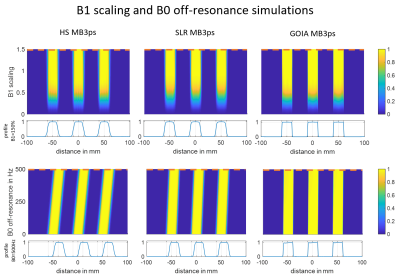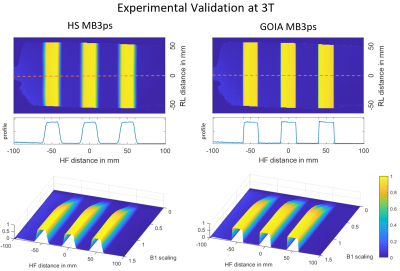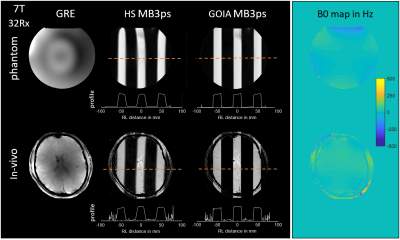3692
Designing B0 robust adiabatic multi-band inversion pulses with high time-bandwidth products and smooth slice selective gradients1Physikalisch-Technische Bundesanstalt (PTB), Braunschweig and Berlin, Germany
Synopsis
We demonstrate the design of adiabatic multi-band inversion pulses with high time-bandwidth products and acceptable RF power demands. The proposed utilization of GOIA single-band pulses results in smooth slice selective gradients with highly reduced RF power and matched multi-band RF waveforms. Phantom and in vivo experiments at 3T and 7T validate the simulations and demonstrate robust inversion of multiple slices over a wide range of both B1+ and B0 values.
Target audience:
Researchers interested in the field of RF pulse design, SMS imaging and spectroscopy.Purpose:
Ultra-high field MR is often limited by inhomogeneities of the transmit magnetic radio frequency (RF) field (B1+) yielding spatially variable flip angles (FA). Adiabatic RF pulses generate homogeneous FA despite B1+ variations while achieving high spectral or spatial selectivity1. Different approaches have been proposed to increase the bandwidth of adiabatic single-band (SB) pulses by reducing RF peak amplitudes2 or a combined reduction of RF peak amplitudes and RF power3,4. In this work, we extend adiabatic multi-band (MB) pulses5 where RF power becomes an even stronger problem and propose to use low-power gradient-offset independent adiabatic (GOIA4) pulses with the aim to design adiabatic MB pulses with high bandwidth, smooth slice-selective gradient (Gs) shape and increased B0 robustness. The proposed pulses were tested on numerical simulations and validated experimentally at 3T and 7T.Theory:
A frequency offset shifts adiabatic pulses along the spectral or spatial dimension. As for conventional MB pulses6, a spatially selective adiabatic MB pulse is achieved by superposing $$$N$$$ adiabatic SB pulses $$$B_1(t)$$$, each shifted with respect to isocenter to a different spatial position $$$\Delta\,z_n$$$ using $$B_{1,MB}(t)=\sum_{n=1}^{N}B_1(t)e^{i(k(t)\Delta\,z_n+\theta_n)}.$$ Instead of a constant frequency offset we use the more general spatial frequency variable $$$k(t)=-\gamma\int_{0}^{t}G_s(t)\,dt$$$ and $$$\theta_n$$$ for phase scrambling6,7,8. This allows designing MB pulses with arbitrary Gs shapes and can be directly applied to the GOIA waveforms based on n-th-order hyperbolic secant (HS) functions. The GOIA RF phase modulation $$\phi(t)= \frac{2\pi}{Q}\int_{0}^{t}(G_{s}(\tau)\int_{0}^{\tau}\frac{ B_{1}(\tau^´)^2}{G_{s}(\tau^´)}d\tau^´-\omega_c)d\tau,$$ with center frequency $$$\omega_c$$$ was computed for each SB pulse based on numerical integration of the constant adiabatic equation4 with a constant quality factor $$$Q$$$.Methods:
Three different adiabatic inversion pulses, HS1, Shinnar–Le Roux with quadratic phase (SLR)2 and GOIA4,5 were designed in MATLAB (The MathWorks, Inc, Natick, USA) according to Figure 1. The pulses were designed for a duration of 6 ms/12 ms (SB/MB) and temporal discretization of 5 µs to leave room for B1 scaling above the adiabatic threshold. The spectral bandwidth of the pulses ranged from 1.25 kHz (HS) to 4.25 kHz (SLR) and 20 kHz (GOIA). Gradients were designed for a slice thickness of 20 mm and temporal discretization of 10 µs. Three SB pulses, inverting at isocenter or ±50 mm away, were superposed to form an MB pulse without (MB3) and with an optimized phase scrambling scheme (MB3ps)7. The total power of the RF pulse was estimated by $$$\int_{0}^{T}B_1(t)^2\,dt$$$. The MB3ps inversion pulses were implemented in a pulse sequence followed by an orthogonal slice selective excitation and cartesian phase encoding and read-out. High-resolution scans (TR/TE = 2000/4.8 ms, FOV = 256x128 mm, matrix = 384×192, B1 up to 150%) have been acquired on a 3T system (Magnetom Verio, Siemens, Erlangen, Germany) with a 32Rx head coil and on a 7T system (Magnetom, Siemens, Erlangen, Germany) with a 1Tx32Rx head coil. Each scan was performed twice (without and with the adiabatic inversion pulse) and the inversion profiles were calculated by the difference between the two resulting images.Results and Discussion:
Figure 1 lists key parameters for all pulses. It bears mentioning that the GOIA pulse has similar RF power demands as the SLR pulse but has a more than 5 times higher bandwidth. A similar performance might be possible by applying VERSE, but GOIA additionally achieves a constant adiabatic factor across the entire spectral bandwidth4. Compared to HS-MB3ps the proposed GOIA-MB3ps pulse results in a 16 times higher bandwidth with only a 2-fold RF power increase. As expected, phase scrambling of adiabatic MB pulses resulted in a sub-linear scaling of the peak B1+ amplitude and linear scaling of RF power demands with the number of bands. Figure 2 shows the MB3ps waveforms and the simulated inversion profiles. The simulations demonstrate the feasibility of simultaneous triple-slice inversion. While all RF magnitudes and phases vary rapidly, the Gs waveform (for GOIA) is smooth and does not require correction of gradient imperfections8,9. Figure 3 shows simulated inversion profiles (scaled from 0 to 1) of the Mb3ps pulses for a B1+ variation of 0-150% and off-resonance frequencies from 0-500 Hz. The pulses perform similar near the adiabatic (B1) threshold but differ in off-resonance sensitivity. A 500 Hz B0 offset shifts the inversion profiles by 12 mm (HS), 5.4 mm (SLR) and only 1.2 mm (GOIA). Notably, the GOIA-MB3ps pulse achieves inversion profiles with a maximal error of only 2.5% at 500 Hz, despite the time-varying gradient. Figure 4 shows the reconstructed inversion profiles for HS- and GOIA-MB3ps from 3T phantom measurements. B1 was varied up to 150% in eleven steps and the results reproduce the Bloch simulations shown in Figures 2 and 3. Figure 5 shows phantom and in-vivo inversion profiles measured at 7T together with GRE reference scans and B0 maps. Again, the measurements agree well with the simulations and clearly demonstrate the robustness and practical applicability of the GOIA-MB3ps pulses.Conclusion
Bloch simulations and measurements at 3T and 7T consistently confirm the hypothesized potential of phase-scrambled adiabatic GOIA-MB pulses. These pulses will serve as a basis to reduce effective echo time and chemical shift artifacts in multi-voxel spectroscopy.Acknowledgements
No acknowledgement found.References
1) Tannus A, Garwood M. Adiabatic pulses. NMR Biomed 1997; 10: 423–434.
2) Balchandani P, Pauly J and Spielman D, Designing adiabatic radio frequency pulses using the Shinnar–Le Roux algorithm. Magn. Reson. Med., 64: 843-851, 2010 doi:10.1002/mrm.22473
3) Warnking JM and Pike GB, Bandwidth‐modulated adiabatic RF pulses for uniform selective saturation and inversion. Magn. Reson. Med., 52: 1190-1199, 2004 doi:10.1002/mrm.20262
4) Andronesi OC, Ramadan S, Ratai EM, Jennings D, Mountford CE and Sorensen AG, Spectroscopic imaging with improved gradient modulated constant adiabaticity pulses on high-field clinical scanners. J. Magn. Reson., 203(2): 283-293, 2010. doi: 10.1016/j.jmr.2010.01.010.
5) Goelman G and Leigh JS, Multiband Adiabatic Inversion Pulses. J. Magn. Reson. 101(2): 136-146, 1993. doi: 10.1006/jmra.1993.1023.
6) Barth M, Breuer F, Koopmans PJ, Norris DG and Poser BA. Simultaneous multislice (SMS) imaging techniques. Magn. Reson. Med. 75(1):63–81, 2016.
7) Wong EC, Optimized phase schedules for minimizing peak RFpower in simultaneous multi-slice RF excitation pulses. Proc.Intl.Soc.Mag.Reson.Med. 2012;(20):2209
8) S. Abo Seada, A.N. Price, T. Schneider, J.V. Hajnal, S.J. Malik, Multiband RF pulse design for realistic gradient performance. Magn Reson Med. 2019; 81: 362– 376. https://doi.org/10.1002/mrm.27411
9) C.S. Aigner, A. Rund, S. Abo Seada, S. Malik, J.V. Hajnal, K. Kunisch and R. Stollberger. Time-optimal control based RF pulse design under gradient imperfections. Magn. Reson. Med. 2019; 00: 1– 14. https://doi.org/10.1002/mrm.27955
Figures




